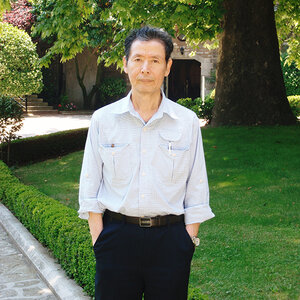Making Waves and Riding the Currents: Activism and the Practice of Wisdom
In the closing chapters of Anna Karenina, the skeptical, restless landowner Konstantin Levin experiences an epiphany following a conversation with a peasant regarding "men who live for their bellies" versus "men who live for their souls." After hours of silent rumination alone on the Russian steppe, Levin notices that the everyday irritations of life remain present in the midst of his newfound spiritual peace, but that his peace nonetheless remains untouched.
Social entrepreneur Charles Halpern may have a hint of a Levin inside him, as evidenced by his book Making Waves and Riding the Currents: Activism and the Practice of Wisdom. Like the landowning Levin, Halpern's path to the top was laid out for him at an early age: the son of a judge, he received degrees from Harvard and Yale before finding himself at Arnold & Porter, a prominent law firm, in the late 1960s. It didn't take long, however, for him to become unsettled by the contrast between his progressive politics and his workdays spent facilitating corporate takeovers. Eager to find more meaningful work, he left Arnold & Porter and, before the age of thirty, established America's first public interest law firm.
Making Waves and Riding the Currents is the tale of how Halpern achieved balance in his life. Along the way, he fashioned a brilliant career in the social justice arena, beginning with the creation of the Center for Law and Social Policy, continuing through his founding deanship at the City University of New York's public interest law school, and culminating in his tenure as president of the New York City-based Nathan Cummings Foundation. At the same time, the stress, heavy workload, and ongoing conflicts inherent in his career choices exacted a toll. Recognizing that the cognitive skills he had been taught in law school were not enough to meet the challenge of work that demanded compassion and self-sacrifice, he concluded that he needed to nourish his inner self and learn, as he puts it, to "cultivate wisdom."
No surprise then that a large portion of the book takes place not in an office but in wilderness retreats, meditation sessions, and self-awareness workshops. Many passages are devoted to Halpern's favorite pastime, canoeing. Indeed, it is the challenge of navigating a narrow open boat through sometimes treacherous waters that inspires the book's extended metaphor of waves and currents. And it's in nature that Halpern discovers within himself the inner calm and balance necessary to confront problems clear-headedly and without ideological filters or preconceptions. Halpern also gives much credit for his spiritual development to his friend Ralph Siu, who led the author to his initial breakthrough when he told him, "There is a natural rhythm in things, and your work will be more effective if you bring your efforts into harmony with those natural rhythms."
Halpern's book serves two purposes: as the memoir of a celebrated activist and social entrepreneur, and as a self-help book for the beleaguered social change crusader. As memoir, the book gives readers an idea of how a person can make a career out of working to change the world for the better. It also offers an inside perspective from a former foundation president, which can be useful for anyone working in or with a foundation. As self-help book, Making Waves offers succor for frustrated activists determined to make waves but weighed down by stress, disillusionment, and the everyday difficulties of social change work. At a time when people's minds are too often clouded by anxiety and fatigue to think about their work clearly, no one could argue with Halpern's advice to make time for solitude and contemplation.
The trouble with that approach is that unless the reader has never heard of meditation or the benefits of a long solitary walk in the woods, the author doesn't really offer many new ideas. In a day and age when everyone and his mother takes yoga classes or learns about soul nourishment from Oprah, the concepts of meditation and nature retreats simply aren't as groundbreaking as Halpern found them to be forty years ago. What's more, some of the avenues Halpern pursues in his soul-searching — expensive workshops and retreats, second homes in the wilderness, a visit with the Dalai Lama — could be rather alienating to a grassroots activist living on a typical nonprofit sector salary. The fact that much of Halpern's pursuit of wisdom is buoyed by ample disposable income and connections to people in high places tends to muffle his message.
And yet, Halpern's main point rings true: In order to do good work while remaining a whole person, a certain amount of reflection is essential. That reflection can take place in a lakeside seminar led by a Buddhist monk, or it can just as easily take place in one's own backyard with a copy of the Tao Te Ching. As the work of doing good becomes ever-more bureaucratized and punctuated by meetings, endless paperwork, and workplace conflicts, activists and change agents increasingly are susceptible to losing sight of the big picture. Making Waves and Riding the Currents is a refreshing antidote to those trends and an important reminder to all to focus on what truly matters, both in work and in life. Halpern's career, chronicled here, serves as an example of the good that can follow when individuals who care passionately about the world around them forget to live for their bellies and, like Konstantin Levin, remember to live for their souls.








